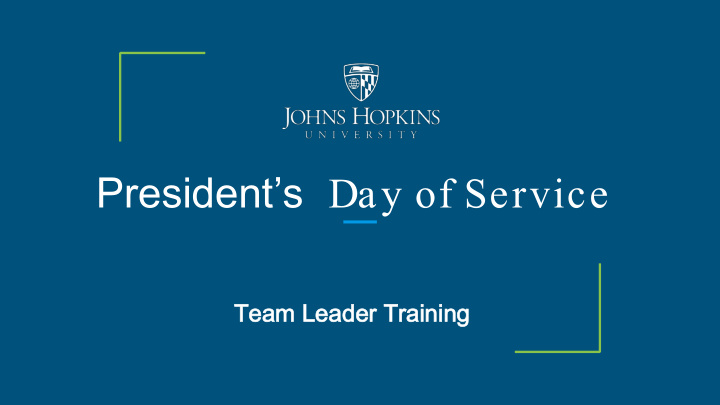



President’s Day of Service Team Leader Training Team Leader Training
Overview I. Overview of PDOS Goals II. Team Leader Role & Major Responsibilities III. Day-of Schedule and Logistics IV. Emergency Procedures V. Scenarios VI. Facilitating Reflection VII.Q&A
PDOS Goals 1. Recommit to our community partners to change perceptions about the Hopkins community. 2. Make PDOS a catalyst for a career of service in our Baltimore and Hopkins communities. 3. Promote challenging conversations about systems and spark unlearning of dominant narrative through reflection.
Team Leader Role and Major Responsibilities
A President’s Day of Service Team Leader is... ❖ a role model for student volunteers; ❖ a representative of the Johns Hopkins University; and ❖ a facilitator of reflection.
What are your responsibilities before and during PDOS? th at 1. Attend Community Partner Orientation on Wednesday, September 18 6:30pm at the Homewood Friends Meeting House 2. Act as a point contact for the PDOS team. a. Email and disseminate information to volunteers. 3. Aiding in Day of Procedures a. Account for all members of your team b. Assist in risk management 4. Serve as a facilitator a. Assist in the facilitation of the project overview with your communitiy partner on site b. Serve as the main facilitator of our post-event reflection discussion
Before PDOS... ❖ Familiarize yourself with your project description, site mission/vision, and transportation assignment. ❖ Send an email to your volunteers by by Thursday, September 19th Thursday, September 19th introducing yourself and providing them with your day-of contact information. ➢ CC Teya Bergamaschi (tbergam1@jhu.edu) and Young Song (ysong@jhu.edu).
Day -of Schedule 8:15AM Team Leaders arrive (3 locations) 8:15AM – 8:45AM Team Leader check-in (3 locations) 9:00AM – 9:30AM Participant check-in 9:30AM Busses leave (to service site) 10:00AM – 1:00PM Service Project 1:00PM – 1:30PM Busses return (to campus) 1:30PM – 1:55PM Food 1:55PM – 2:00PM Welcome 2:00PM – 2:20PM Fireside chat with Senator Mikulski 2:20PM – 3:00PM Post-Event Reflection
During PDOS (Before Service) ❖ Check-in by 8:15AM. ❖ Grab a Team Leader PDOS T-shirt and a backpack! ❖ Pick up your Team Leader folder. ❖ Attend short Team Leader briefing for further instructions. ❖ Go to your assigned bus or meeting area. ❖ Await dismissal instructions.
Team Leader Folder Contents Full Volunteer Roster (with contact information) Day-of Emergency Guide Allergies and/or Important Medical Information Team Leader Materials Checklist Baltimore Community ToolBank Order Transportation type and information If walking, map If taking a bus, zone and bus number Community Partner Information Post-Service Reflection Facilitation Guide Nametags Group Number Sign
During PDOS (During Service) ❖ Facilitate the introduction of the community partner and prompt them to share an overview of their organization and neighborhood. ❖ Demonstrate cultural humility towards your community partner. ❖ Serve as a role model for fellow volunteers. ❖ Follow emergency procedures (if applicable).
Emergency Procedures
In an emergency... ❖ Don’t panic. ❖ Determine the severity of the emergency: ➢ For medical emergencies, first call 911. Then call contact person to let them know what is happening. ➢ For non-medical emergencies, call contact person. If they are unavailable, move on to the next number. ❖ If no one answers, keep calling. ❖ Stay calm and communicate effectively with the person affected, the community partner, and the PDOS team.
Day of Emergency Contacts You will receive a full list of emergency contacts on the day of PDOS For now please save these numbers as emergency contacts for PDOS: Kelly – (908) 581 - 0777 Ami – (248) 766 – 2612
Scenarios
During PDOS (After Service) ❖ Site and tool return to campus (if applicable) ❖ All volunteers MUST return to the Rec Center for a post -service reflection reception. ➢ Note: The reception begins promptly at 1:30PM, so please be back at the Rec Center on time. ❖ Facilitate reflection with a group of your peers.
What is Reflection?
Reflection in Service -Learning Reflection is the process by which participants mentally and emotionally synthesize direct service and education.
Facilitating Reflection When facilitating a reflection after a service Facilitation is the art of leading experience, the goal is to have participants people through a process toward think about the following: agreed-upon objectives in a What did I do during my service manner that encourages experience? (WHAT) participation, ownership, and Why does it matter? (SO WHAT) How should I respond moving forward? productivity from all involved . (NOW WHAT)
Being a Facilitator ❖ Be comfortable with silence ❖ Practice observation ❖ Be willing to be vulnerable ❖ Highlight identities both in the group and outside of the group
Q&A
Recommend
More recommend